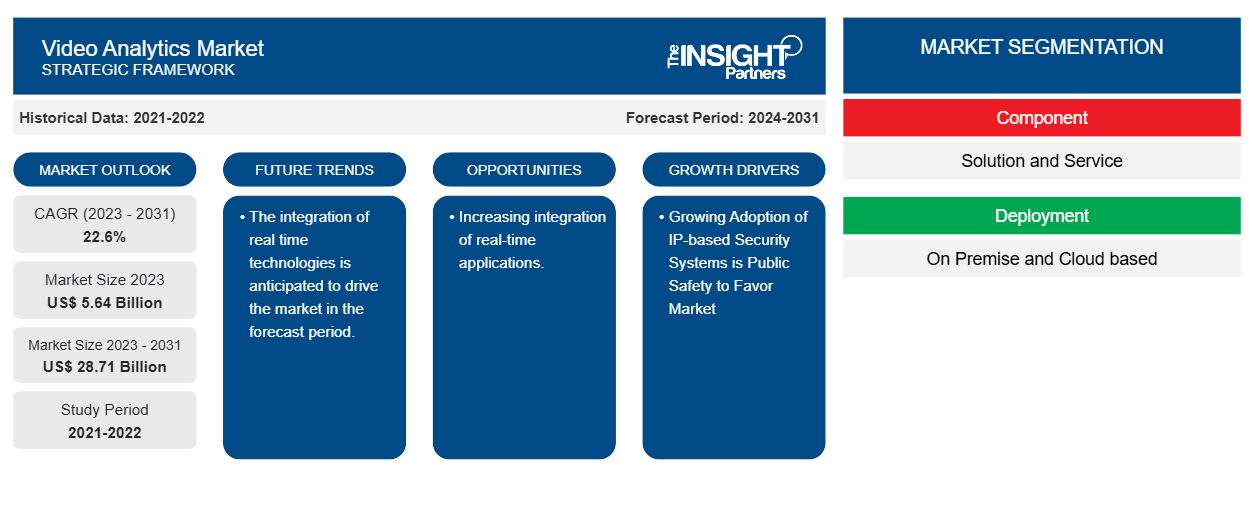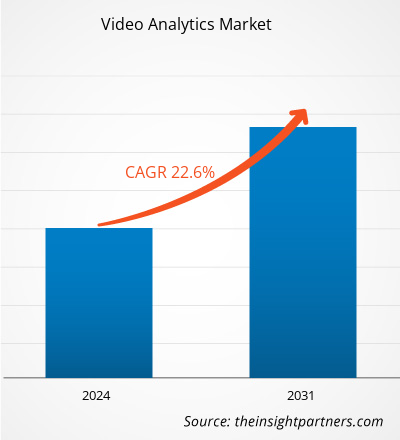The video analytics market size is projected to reach US$ 28.71 billion by 2031 from US$ 5.64 billion in 2023. The market is expected to register a CAGR of 22.6% during 2023–2031. The growing adoption of IP-based security systems in public safety applications and the development of advanced systems for precision monitoring are likely to be the key drivers and trends of the market.
Video Analytics Market Analysis
The video analytics market is experiencing significant growth globally. This growth is attributed to factors such as the growing adoption of IP-based security systems in public safety applications and the development of advanced systems for precision monitoring. Moreover, the integration of new technologies and integration of real-time technologies is anticipated to hold several opportunities for the market in coming years.
Video Analytics Market Overview
Video analytics process video in real time and transform it into intelligent data. They automatically generate descriptions of what is happening in the metadata. They are utilized to detect and track objects which also could be categorized as vehicles, persons, and other objects in the video stream. Video analytics is a practical solution to reviewing hours of surveillance video to identify incidents that are significant to what you are looking for.
Customize This Report To Suit Your Requirement
You will get customization on any report - free of charge - including parts of this report, or country-level analysis, Excel Data pack, as well as avail great offers and discounts for start-ups & universities
Video Analytics Market: Strategic Insights

-
Get Top Key Market Trends of this report.This FREE sample will include data analysis, ranging from market trends to estimates and forecasts.
Video Analytics Market Drivers and Opportunities
Growing Adoption of IP-based Security Systems is Public Safety to Favor Market
Video surveillance in the present day is more than just monitoring, recording and storage. With changing society and increasing threat scenarios, video surveillance has gained importance across the globe. The increase in demand for IP-based security cameras has encouraged the robust growth of the video analytics industry, which has introduced a new era of smart surveillance and data-oriented observations. The inclusion of IP cameras and video analytics fundamentally transforms the security landscape in several ways, including Improved accuracy and precision, threat detection in real-time, enhanced cost-effectiveness and resource allocation optimization, business intelligence and data analysis, Integration with IoT and cloud technologies, and ensuring compliance with rules and regulations.
Increasing integration of real-time applications.
Real-time video analytics is a powerful, cutting-edge technology that leverages advanced algorithms and computational power to analyze video streams instantaneously. This transformative capability enables systems to extract meaningful insights from live video feeds, making it invaluable across various industries. Recent improvements in video analytics have been a game-changer, ranging from applications that monitor traffic jams and alerts in real-time to others that analyze customers’ flow in retail to maximize sales, along with other more well-known scenarios such as facial recognition or smart parking.
Video Analytics Market Report Segmentation Analysis
Key segments that contributed to the derivation of the video analytics market analysis are component, deployment, application, and vertical.
- Based on component, the video analytics market is divided into solution and services. The solution segment is anticipated to hold a significant market share in the forecast period.
- Based on deployment, the video analytics market is divided into on-premise and cloud-based. The radiation hardening by design (RHBD) segment is anticipated to hold a significant market share in the forecast period.
- By application, the market is segmented into crowd management, facial recognition, intrusion detection, license plate recognition, motion detection, and others. The crowd management segment is anticipated to hold a significant market share in the forecast period.
- By vertical, the market is segmented into BFSI, education, hospitality and entertainment, manufacturing, defense and border security, retail, transportation and logistics, and others. The BFSI segment is anticipated to hold a significant market share in the forecast period.
Video Analytics Market Share Analysis by Geography
The geographic scope of the video analytics market report is mainly divided into five regions: North America, Asia Pacific, Europe, Middle East & Africa, and South & Central America.
North America has dominated the video analytics market. High technology adoption trends in various industries in the North American region have fuelled the growth of the video analytics market. Factors such as increased adoption of digital tools and high technological spending by government agencies are expected to drive the North American video analytics market growth. Moreover, a strong emphasis on research and development in the developed economies of the US and Canada is forcing the North American players to bring technologically advanced solutions into the market. In addition, the US has a large number of video analytics market players who have been increasingly focusing on developing innovative solutions. All these factors contribute to the region's growth of the video analytics market.
Video Analytics Market Regional Insights
The regional trends and factors influencing the Video Analytics Market throughout the forecast period have been thoroughly explained by the analysts at The Insight Partners. This section also discusses Video Analytics Market segments and geography across North America, Europe, Asia Pacific, Middle East and Africa, and South and Central America.
Video Analytics Market Report Scope
| Report Attribute | Details |
|---|---|
| Market size in 2023 | US$ 5.64 Billion |
| Market Size by 2031 | US$ 28.71 Billion |
| Global CAGR (2023 - 2031) | 22.6% |
| Historical Data | 2021-2022 |
| Forecast period | 2024-2031 |
| Segments Covered |
By Component
|
| Regions and Countries Covered |
North America
|
| Market leaders and key company profiles |
|
Video Analytics Market Players Density: Understanding Its Impact on Business Dynamics
The Video Analytics Market is growing rapidly, driven by increasing end-user demand due to factors such as evolving consumer preferences, technological advancements, and greater awareness of the product's benefits. As demand rises, businesses are expanding their offerings, innovating to meet consumer needs, and capitalizing on emerging trends, which further fuels market growth.

- Get the Video Analytics Market top key players overview
Video Analytics Market News and Recent Developments
The video analytics market is evaluated by gathering qualitative and quantitative data post primary and secondary research, which includes important corporate publications, association data, and databases. A few of the developments in the video analytics market are listed below:
- Claro Enterprise Solutions, the global integrator specializing in managing secure-by-design cybersecurity and information technology solutions, announced the launch of its AI Video Analytics product, powered by Iveda, the global solution provider for AI video and sensor technologies, to offer an innovative and invaluable tool for enhancing vigilance in public spaces, including school campuses. (Source: Claro Enterprise Solutions, Company Website, May 2023)
- AI in video surveillance is transforming how businesses approach security. Bosch Building Technologies is investing in proactive and intelligent solutions for security and business optimization supporting secure environments in and around buildings, perimeters, and traffic. (Source: Bosch, Company Website, July 2024)
Video Analytics Market Report Coverage and Deliverables
The “Video Analytics Market Size and Forecast (2021–2031)” report provides a detailed analysis of the market covering below areas:
- Video analytics market size and forecast at global, regional, and country levels for all the key market segments covered under the scope
- Video analytics market trends as well as market dynamics such as drivers, restraints, and key opportunities
- Detailed PEST/Porter’s Five Forces and SWOT analysis
- Video analytics market analysis covering key market trends, global and regional framework, major players, regulations, and recent market developments
- Industry landscape and competition analysis covering market concentration, heat map analysis, prominent players, and recent developments for the video analytics market
- Detailed company profiles
Frequently Asked Questions
What is the expected CAGR of the video analytics market?
What would be the estimated value of the video analytics market by 2031?
What are the future trends of the video analytics market?
Which are the leading players operating in the video analytics market?
What are the driving factors impacting the video analytics market?
Which region dominated the video analytics market in 2023?
- Historical Analysis (2 Years), Base Year, Forecast (7 Years) with CAGR
- PEST and SWOT Analysis
- Market Size Value / Volume - Global, Regional, Country
- Industry and Competitive Landscape
- Excel Dataset
Recent Reports
Testimonials
Reason to Buy
- Informed Decision-Making
- Understanding Market Dynamics
- Competitive Analysis
- Identifying Emerging Markets
- Customer Insights
- Market Forecasts
- Risk Mitigation
- Boosting Operational Efficiency
- Strategic Planning
- Investment Justification
- Tracking Industry Innovations
- Aligning with Regulatory Trends





















 Get Free Sample For
Get Free Sample For